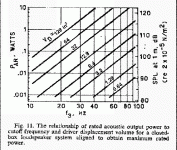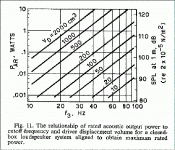I don't have Excel, so Unibox isn't an option for me.
I've downloaded WinISD pro and it has the option of plotting cone excursion and max SPL, but nothing shows up on the graph. Does it need to have the mechanical parameters before it can do this?
In short, how do I model cone excursion and maximum SPL?
Thanks.
I've downloaded WinISD pro and it has the option of plotting cone excursion and max SPL, but nothing shows up on the graph. Does it need to have the mechanical parameters before it can do this?
In short, how do I model cone excursion and maximum SPL?
Thanks.
It doesn't give you a graph and doesn't pop up a box to tell you why?
Check your graph limits first, but if it is just showing a blank graph...what a POS program 😉
You likely need Sd and Bl and Mms at least. Most of these can be calculated from the regular T/S parameters, play around with the parameter editor.....
Sd is something you need to measure, but it is relatively OK to guess:
Sd=pi*Diameter^2/4
Typical Diameter of cones:
nominal frame - actual Piston diameter
6.5" - 13cm
8" - 17cm
10" - 21cm
12" - 26cm
15" - 33cm
18" - 40cm
Check your graph limits first, but if it is just showing a blank graph...what a POS program 😉
You likely need Sd and Bl and Mms at least. Most of these can be calculated from the regular T/S parameters, play around with the parameter editor.....
Sd is something you need to measure, but it is relatively OK to guess:
Sd=pi*Diameter^2/4
Typical Diameter of cones:
nominal frame - actual Piston diameter
6.5" - 13cm
8" - 17cm
10" - 21cm
12" - 26cm
15" - 33cm
18" - 40cm
I don't know of this will work, but you could try the MS Excel viewer.
Edit. Err maybe not. It really is just a 'viewer'.
Edit. Err maybe not. It really is just a 'viewer'.
It does plot excursion at the set power and max SPL from
excursion limits and max power handling.
Sd is needed for the excursion plot, and Sd, max excursion
and max power needed for the maximum SPL plot, at least.
🙂 sreten.
excursion limits and max power handling.
Sd is needed for the excursion plot, and Sd, max excursion
and max power needed for the maximum SPL plot, at least.
🙂 sreten.
Try the free spreadsheet here:
http://download.openoffice.org/1.1.0/index.html
I've had pretty good luck using this open spreadsheet to work with .XLS files, even those with graphics. FYI: Open Office also includes free word processor, presentation application, that are compatible with Word and PowerPoint files.
http://download.openoffice.org/1.1.0/index.html
I've had pretty good luck using this open spreadsheet to work with .XLS files, even those with graphics. FYI: Open Office also includes free word processor, presentation application, that are compatible with Word and PowerPoint files.
These two freeware programs will model SPL and excursion:
A) Subwoofer Simulator by our own member F2ier:
http://www.geocities.com/f4ier/speaker.htm
B) BoxModel by Bullock and White
http://www.hal-pc.org/~bwhitejr/
Note: On BoxModel do not use the TL program. Bullock later admitted the program did not yield results that worked in the real world. For TL models, use Martin J King's freeware MathCAD models: www.quarter-wave.com
The other programs in BoxModel are accurate, however.
By the way, Unibox works with Excel 95 and 97 as well. Just use the earlier version. When you said you don't have Excel, do you mean you don't use a Windoze machine or you just don't have Excel?
A) Subwoofer Simulator by our own member F2ier:
http://www.geocities.com/f4ier/speaker.htm
B) BoxModel by Bullock and White
http://www.hal-pc.org/~bwhitejr/
Note: On BoxModel do not use the TL program. Bullock later admitted the program did not yield results that worked in the real world. For TL models, use Martin J King's freeware MathCAD models: www.quarter-wave.com
The other programs in BoxModel are accurate, however.
By the way, Unibox works with Excel 95 and 97 as well. Just use the earlier version. When you said you don't have Excel, do you mean you don't use a Windoze machine or you just don't have Excel?
O course, another thing you can do is to use the displacement chart below. For closed boxes, just calculate your cone area, multiply by your plus -r minus excursion, and see what your SPL requires.
So you would need 32 cubic inches of air moved, (Sd times plus or minus excursion), to produce 105 dB at 30 Hz.
For vented boxes, where the Fb is somewhere near the Fb, you would require only about one fourth as much air movement. So instead of 32 cubic incheds of air moved, if your Fb is anywhere near 30 Hz, then you would require only 8 cubic inches of air being moved.
See how much more output vented boxes give? That is why, even though they give somewhat more distortion, the vented box should be your first choice for bass output, (unless you are one of those people who really don't like the sound of them).
So you would need 32 cubic inches of air moved, (Sd times plus or minus excursion), to produce 105 dB at 30 Hz.
For vented boxes, where the Fb is somewhere near the Fb, you would require only about one fourth as much air movement. So instead of 32 cubic incheds of air moved, if your Fb is anywhere near 30 Hz, then you would require only 8 cubic inches of air being moved.
See how much more output vented boxes give? That is why, even though they give somewhat more distortion, the vented box should be your first choice for bass output, (unless you are one of those people who really don't like the sound of them).
Attachments
- Status
- Not open for further replies.
- Home
- Loudspeakers
- Multi-Way
- Modeling cone excursion / max SPL wihtout Excel

